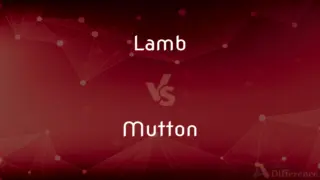Slat vs. Louver — What's the Difference?
By Fiza Rafique & Urooj Arif — Updated on April 26, 2024
Slats are thin, flat strips used in various structures, providing support and coverage, while louvers consist of angled slats designed to admit light and air but block rain and direct sunlight.

Difference Between Slat and Louver
Table of Contents
ADVERTISEMENT
Key Differences
Slats are typically straight, flat pieces used in furniture, blinds, and fences, providing structural support and aesthetic appeal. In contrast, louvers are assemblies of slats arranged at an angle to regulate airflow and light penetration, often seen in vents and shutters.
While slats may be simply aligned side by side or spaced for various uses, louvers are specifically designed to offer directional control over environmental elements, such as light and air, making them particularly useful for climate control in buildings.
The function of slats can be purely structural or decorative, with applications ranging from bed frames to garden benches. On the other hand, louvers serve more specialized functions, such as preventing water ingress while allowing ventilation, commonly used in architectural designs.
In terms of installation, slats are straightforward and can be part of a DIY project, like creating a slatted wood fence. Conversely, louvers require more precise alignment and are often part of a pre-fabricated system, such as louvered windows or doors.
Understanding the specific needs of a project can help in choosing between slats and louvers; slats are versatile for general use, whereas louvers are optimal for specific environmental control applications.
ADVERTISEMENT
Comparison Chart
Definition
Flat strips used for support and coverage
Angled slats designed to control light and air flow
Function
Structural, decorative
Environmental control, ventilation
Applications
Furniture, blinds, fencing
Windows, shutters, vents
Installation
Often simple and DIY-friendly
Typically requires precise alignment and may be pre-fabricated
Use in Buildings
Primarily decorative or supportive
Functional, often related to climate control
Compare with Definitions
Slat
Commonly found in outdoor and indoor furniture.
Slatted chair designs are popular for patio settings.
Louver
Arrangements of parallel slats angled to manage sunlight and airflow.
The louvered doors were ideal for maintaining privacy while ventilating the room.
Slat
Used in window treatments like blinds.
Adjust the slats to control how much light enters the room.
Louver
Designed to block direct sunlight and rain.
Louvers on the exterior window shield the room from harsh sunlight.
Slat
Serve both decorative and functional purposes.
Vertical slats on the wall add a modern touch to the room.
Louver
Integral to building ventilation systems.
The building's design includes louvers for natural air conditioning.
Slat
Can be horizontal or vertical based on application.
Horizontal slats provide better support for bedding in a frame.
Louver
Adjustable models allow for varying degrees of openness.
Adjust the louvers to increase or decrease the amount of incoming air.
Slat
Thin, flat pieces of wood, metal, or plastic used in various constructions.
The wooden slats of the bench make it comfortable and stylish.
Louver
Often used in automotive and aircraft designs for cooling.
The sports car features louvers over the engine bay for better cooling.
Slat
A narrow strip of metal or wood, as in a Venetian blind.
Louver
A louver (American English) or louvre (British English; see spelling differences) is a window blind or shutter with horizontal slats that are angled to admit light and air, but to keep out rain and direct sunshine. The angle of the slats may be adjustable, usually in blinds and windows, or fixed.
Slat
A movable auxiliary airfoil running along the leading edge of the wing of an airplane.
Louver
A framed opening, as in a wall, door, or window, fitted with fixed or movable horizontal slats for admitting air or light and often for shedding rain.
Slat
Slats(Slang) The ribs.
Louver
One of the slats used in such an opening.
Slat
To provide or make with slats
Slatting the back of a chair.
Louver
One of the narrow openings formed by such slats.
Slat
A thin, narrow strip or bar of wood (lath), metal, or plastic.
Slats of a window blind
Louver
A slatted, ventilating opening, as on the hood of a motor vehicle.
Slat
(aviation) A control surface that extends forwards and downwards from the leading edge of a wing, leaving a gap between it and the leading edge, in order to modify the airflow around the wing so as to allow flight at a higher angle of attack without stalling, lowering the aircraft's stall speed.
Louver
A lantern-shaped cupola on the roof of a medieval building for admitting air and providing for the escape of smoke.
Slat
A ski.
Louver
A type of turret on the roof of certain medieval buildings designed to allow ventilation or the admission of light.
Slat
A thin piece of stone; a slate.
Louver
A series of sloping overlapping slats or boards which admit air and light but exclude rain etc.
Slat
To construct or provide with slats.
Louver
Any of a system of slits, as in the hood of an automobile, for ventilation.
Slat
To slap or strike; to beat, pummel; to hurl or throw down violently.
Louver
A small lantern. See Lantern, 2 (a).
Slat
To split; to crack.
Louver
Same as louver boards, below
Slat
To set on; to incite.
Louver
A set of slats resembling louver boards, arranged in a vertical row and attached at each slat end to a frame inserted in or part of a door or window; the slats may be made of wood, plastic, or metal, and the angle of inclination of the slats may be adjustable simultaneously, to allow more or less light or air into the enclosure.
Slat
A thin, narrow strip or bar of wood or metal; as, the slats of a window blind.
Louver
To supply with louvers.
Slat
To slap; to strike; to beat; to throw down violently.
How did you kill him?Slat[t]ed his brains out.
Louver
One of a set of parallel slats in a door or window to admit air and reject rain
Slat
To split; to crack.
Slat
To set on; to incite. See 3d Slate.
Slat
A thin strip (wood or metal)
Slat
Equip or bar with slats;
Slat the windows
Slat
Close the slats of (windows)
Common Curiosities
What is a slat?
A slat is a thin, flat strip used in various structures for support or coverage.
What are the primary functions of louvers?
Louvers are used for environmental control, particularly in managing airflow and light in buildings.
What is a louver?
A louver consists of angled slats designed to regulate light and air while blocking elements like rain.
Where are slats commonly used?
Slats are used in furniture, window blinds, and fencing.
Are slats suitable for outdoor use?
Yes, when made from appropriate materials, slats are suitable for outdoor structures like benches and fences.
How do louvers benefit building ventilation?
Louvers allow natural ventilation while protecting against rain and direct sunlight, enhancing comfort without the need for mechanical cooling.
Can louvers be adjusted?
Yes, many louvers are adjustable to control the degree of openness for light and air flow.
Are slats decorative or functional?
Slats can be both decorative and functional, depending on their application.
What materials are used to make louvers?
Louvers can be made from wood, metal, or plastic, depending on the specific needs of the application.
Can slats be used in ceiling designs?
Yes, slats can be effectively used in ceiling designs for aesthetic appeal and to create unique architectural features.
Share Your Discovery

Previous Comparison
Pinnate vs. Palmate
Next Comparison
Lamb vs. MuttonAuthor Spotlight
Written by
Fiza RafiqueFiza Rafique is a skilled content writer at AskDifference.com, where she meticulously refines and enhances written pieces. Drawing from her vast editorial expertise, Fiza ensures clarity, accuracy, and precision in every article. Passionate about language, she continually seeks to elevate the quality of content for readers worldwide.
Co-written by
Urooj ArifUrooj is a skilled content writer at Ask Difference, known for her exceptional ability to simplify complex topics into engaging and informative content. With a passion for research and a flair for clear, concise writing, she consistently delivers articles that resonate with our diverse audience.














































